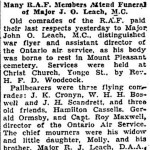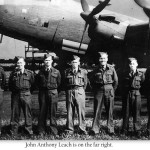

| Personal Details | |
| Date of Birth | September 17, 1893 |
| Place of Birth | St. Catharines, Ontario |
| Country | Canada |
| Marital Status | Single |
| Next of Kin | Frederick Hugh Leach (father), 4 South Drive, Toronto, Ontario |
| Trade / Calling | Surveyor |
| Religion | Church of England |
| Service Details | |
| Regimental Number | N/A |
| Service Record | Link to Service Record |
| Battalion | 1st Central Ontario Regiment |
| Force | Canadian Expeditionary Force |
| Branch | Canadian Infantry |
| Enlisted / Conscripted | Enlisted |
| Date of Enlistment | September 20, 1914 |
| Age at Enlistment | 21 |
| Theatre of Service | Europe |
| Prisoner of War | No |
| Survived War | Yes |
| Death Details | |
| Date of Death | June 29, 1930 |
| Age at Death | 36 |
| Buried At | Mount Pleasant Cemetery, Toronto, Ontario |
| Plot | Plot H Lot 63 B |
Leach, John Owen
Captain John Owen Leach enlisted with the first Canadian contingent in September 1914 and three months later he was commissioned as an officer in the British army. He went on to serve with the Royal Flyings Corps and the Royal Air Force and earned both the Military Cross and the Air Force Cross.
John was the son of Frederick Hugh Leach and Emeline Harriett Parkinson of Toronto, Ontario. Frederick was born in Ontario and Emeline in Breconshire, Wales. They were married in Breconshire in 1890 and came to Canada the following year. A son, Richard James, was born in Toronto in November 1891. John Owen was born on 17 September 1893 followed by William Buck in 1894, both in St. Catharines. Their father was a bank clerk and later an accountant and bank manager. All three boys served in the First World War and Richard and John both earned the Military Cross.
Britain declared war on 4 August 1914 and volunteers for the first Canadian contingent were told to sign up with their local militia then proceed to Valcartier, an area northwest of Quebec City that would become the site of a large military camp. John had attended the Royal Military College for one year and he was working as a surveyor that summer. His brother Richard was already an officer in the militia and they both enlisted at Valcartier in September. John joined the Royal Canadian Horse Artillery Brigade in the Canadian Field Artillery. His unit sailed in early October on the SS Athenia and SS Manitou, as part of a convoy of 32 transport ships protected by a Royal Navy escort because of the danger from German submarines. They arrived safely in Plymouth, England on 14 October.
The Canadians trained on Salisbury Plain in southern England for several months. In December John was commissioned as a officer in the British Army. He served as a Second Lieutenant with the 11th Battalion Middlesex Regiment until May 1916 and during that time (in 1915) he earned the Military Cross. He started training as a pilot in May and on 8 July he was appointed as a Flight Officer in the Royal Flying Corps. In February 1917 he became Flight Commander and in March he was assigned to No. 56 Squadron. He served with his unit as an SE5 pilot and flew on missions in France. He was on wounded on 7 May 1917 when his squadron encountered German aircraft during an evening patrol. He suffered serious inuries to his right leg and had to have it amputated below the knee.
John was married by the summer of 1917. His wife, Ottilie Schreiber, joined him in England and after John’s recovery they both returned to Canada for awhile. They arrived in Halifax on 27 August 1917 on the SS Megantic, on their way to Toronto. Their daughter, Ottilie Marion (Molly), was born later that same year. On 1 April 1918 the Royal Flying Corps and the Royal Naval Air Service were amalgamated to form the Royal Air Force. John served at the headquarters of Royal Air Force (Canada) and with No. 90 (Canadian) Training Squadron, based in Doncaster, Ontario. In December 1918 he and his family returned to England. His wife and daughter arrived in Liverpool three days after Christmas on the SS Minnedosa and John may have travelled on the same ship. On 1 January 1919 he was awarded the Air Force Cross.
On 1 April 1919 John was transferred to the 1st Central Ontario Regiment, Canadian Infantry, as a Captain. He was seconded for duty with the Canadian Air Force where he served until 8 July, some of that time with No. 1 Canadian Wing. He and his wife embarked for Canada on 1 August on the SS Lapland, arriving in Halifax a week later. John was discharged on demobilization on 13 August. His brother William had enlisted in March 1915 and he suffered shell shock and injuries causing deafness at the Somme, while serving with Princess Patricia’s Canadian Light Infantry. He returned to Canada in December 1917. Richard had arrived in England with the first Canadian contingent in October 1914 and he survived the war, returning to Canada in 1919.
When the 1921 census was taken John and his family were living in Chinguacousy Township, Peel County, Ontario where they were farming. He and Ottilie had two more children, John Anthony (1921) and James. John went on to have a career in aviation and worked for the Ontario Provincial Air Service, Forestry Branch. His job took him to Kenora, Ontario in 1926 and the following year he was appointed station superintendent in Sioux Lookout. He spent a year working for the Ford Company then returned to the Air Service and became assistant director in 1930. He was living in Barrie, Ontario at the time.
John was killed in a tragic accident in Port Arthur, Ontario on 29 June 1930. He was performing aerial acrobatics in front of a large crowd of onlookers when his seaplane plunged into the lake. He was 36 years old. His funeral was held in Toronto on 2 July and he’s buried there in Mount Pleasant Cemetery. His parents both died in Victoria, British Columbia, his mother in 1941 and his father in January 1943. John’s son John Anthony served in the Royal Canadian Air Force during the Second World War. He was killed on 27 September 1943 during a bombing mission over Germany and he’s buried in Hanover War Cemetery in Germany. John’s daughter Molly served with the Women’s Division of the Royal Canadian Air Force during the war. His widow Ottilie married Colonel Douglas (Dougal) Herbert Campbell Mason in 1953 in Toronto. Colonel Mason had a long military career and served in both world wars.
John’s older brother, Brigadier Richard James Leach, also had a long military career. During the Second World War he was Commanding Officer of 1st Army Group Royal Canadian Artillery from September 1941 to January 1944. Richard passed away in Ottawa on 1 November 1968, at age 76, and he’s buried in Mount Hermon Cemetery in Quebec City. His wife Constance died in 1976. John’s younger brother William died Victoria in 1972 and his daughter Molly (Mrs. Dalzel Browne) in 2005.
By Becky Johnson
Photo of John Owen is from Great Britain, Royal Aero Club Aviators’ Certificates, 1910-1950 on Ancestry.com.









